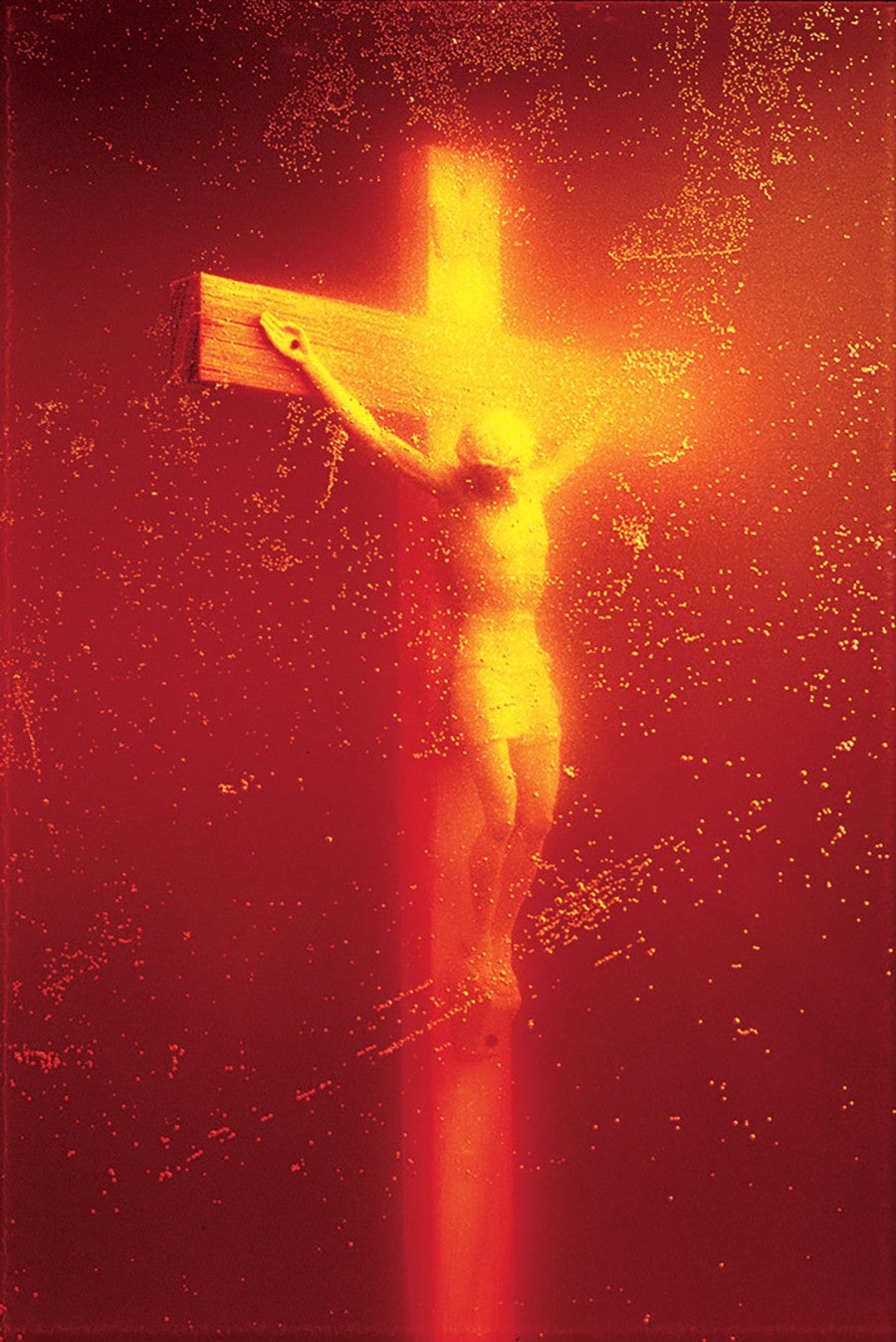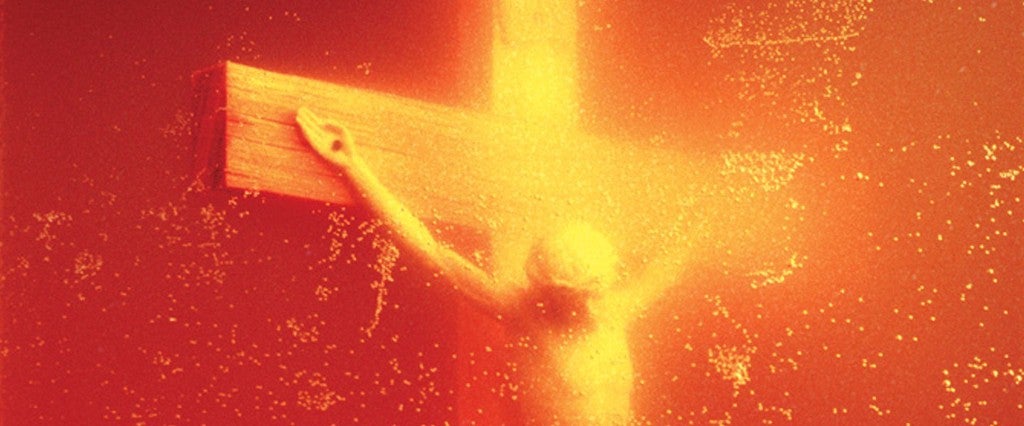News that Trump has proposed defunding the National Endowment of the Arts, a grants system created in 1965 for promoting arts and the humanities, struck fear in the hearts of artists, art lovers and the organizations who support them. But it also provoked conservatives to trot out a very dusty argument about what exactly the NEA is good for, anyway. The argument goes something like this: The NEA needs to go because it funds garbage atheist liberal art. Case in point: Andres Serrano’s “Piss Christ,” a photograph of a 13-inch plastic crucifix immersed in his own urine. The problem is not only that this photograph (and the accompanying argument) is 30 years old, but also that it remains wildly misunderstood.
“Let’s pretend, counterfactually, that the NEA no longer funds the sort of rubbish that once immersed it in the culture wars, e.g., ‘Piss Christ’ (a photograph depicting a crucifix immersed in a jar of the artist’s urine) and ‘Genital Wallpaper’ (don’t ask),” George Will writes in an op-ed at The Washington Post. “What, however, is art?”
Other conservatives have weighed in on this age-old question: “Now we’re getting the usual routine about how defunding the NEA would harm the ‘arts,’” Daniel Greenfield at writes at Front Page. “As if people don’t remember Karen Finley and the garbage that the NEA actually funds. Here’s a reminder. The NEA helped fund ‘Piss Christ.’ It’s exactly what it sounds like.”
Only it’s not exactly what it sounds like. ‘Piss Christ’ is a picture of a crucifix in urine (a tank, not a jar, though). It was created by Serrano, a New York artist and photographer whose work often traffics in complex, visceral juxtapositions involving bodily fluids like semen, milk and blood. Serrano received a $15,000 grant from the NEA in 1987, according to the Post.
But the NEA didn’t actually select him. “In 1987, a five-member jury including Hirshhorn curator Ned Rifkin selected Serrano and nine others to receive $15,000 fellowships from the Southeastern Center for Contemporary Art, as part of a program the NEA has helped support at the Winston-Salem institution since 1981,” the Post explained in 1989. (Serrano did receive a $5,000 grant from the NEA in 1986.)
The photograph wasn’t a big deal when it first debuted at the Stux Gallery in New York in 1989, according to a history of the piece at art blog Blouin Art Info. It wasn’t until it showed up in Richmond, Virginia’s Museum of Fine Arts on an exhibition tour that it began to rankle. In March of that year, concerned citizen Philip L. Smith wrote to the Richmond-Times Dispatch that the museum “should not be in the business of promoting and subsidizing hatred and intolerance,” the blog notes.

“Would they pay the KKK to do a work defaming blacks? Would they display a Jewish symbol under urine? Has Christianity become fair game in our society for any kind of blasphemy and slander?”
When a reverend at the American Family Association spotted the letter and the museum director’s response, he began making noise. He wrote about it in the AFA’s journal, and sent a letter to every member of congress. Soon Sen. Alphonse D’Amato (R-N.Y.) and Sen. Jesse Helms (R-N.C.) were complaining about Serrano on the senate floor, and soon 50 senators and 150 representatives would complain to the NEA. D’Amato called the work “Shocking, abhorrent and completely undeserving of any recognition whatsoever.” Helms said “Serrano is not an artist. He is a jerk. Let him be a jerk on his own time and with his own resources. Do not dishonor our Lord.”
The NEA was obligated to respond. “I most certainly can understand that the work in question has offended many people and appreciate the feelings of those who have protested it,” then-chairman Hugh Southern said of the complaints. “I personally found it offensive.” He explained that the NEA isn’t in the business of interfering with the works they fund, but the controversy had prompted them to review their process and make sure they “maintain the highest artistic integrity and quality.”
Still, Southern added, this was just one grant given out among 80,000 in the quarter-century the NEA had been handing out money. After all, the NEA has also funded Sesame Street, Alice Walker’s The Color Purple, the Broadway play Rent and the Vietnam Veterans Memorial Wall. But “Piss Christ” would be the NEA’s most memorable contribution, and it quickly became the go-to symbol of both how artistic freedom is defined and the 1990s culture wars — were we a progressive, inclusive country who would embrace homosexuality, pornography, challenging art, feminism and multiculturalism? Or were we not still God-fearing Christians with family values?
“Because some artist decides to shock the hicks by dunking Jesus in urine,” author Thomas Frank wrote in 2005 of the photograph’s symbolism in the culture wars, “the entire planet must remake itself along the lines preferred by the Republican Party, U.S.A.”
Many critics defended the piece. “The photograph is clean and purified, the reliquary or shrine in which he clearly believes that the word about the body can be stored and spread,” New York Times art critic Michael Brenson wrote in 1989. “People may agree or disagree with him, or they may question his belief in photography, but how can anyone find in his work just obscenity and disrespect? It is hard to believe that anyone whose faith is searching and secure would not be grateful for what Mr. Serrano has done.”
What’s interesting about all the hullabaloo is that Serrano identifies as a lifelong Christian, and has long maintained that “Piss Christ” (whose full title is “Immersion: Piss Christ”) is not political, but an act of devotion, a reflection of his relationship to the crucifix as a tarnished symbol, and his childhood teaching that Christ shouldn’t be idolized. The piss isn’t what Serrano did to Christ; rather, it’s what we did to Christ over centuries of commercializing him. The Huffington Post asked him in 2004 what the message of the work was, then or now. Serrano responded:
The only message is that I’m a Christian artist making a religious work of art based on my relationship with Christ and The Church. The crucifix is a symbol that has lost its true meaning; the horror of what occurred. It represents the crucifixion of a man who was tortured, humiliated and left to die on a cross for several hours. In that time, Christ not only bled to dead, he probably saw all his bodily functions and fluids come out of him. So if ‘Piss Christ’ upsets people, maybe this is so because it is bringing the symbol closer to its original meaning. There was a time prior to the 17th century when the only important art, the only art that mattered, was religious art. After that, there were very few contemporary art pieces that were considered both art and religious, and ‘Piss Christ’ is one of them.
The work continues to generate controversy, not just for conservatives who want to napalm the NEA, but for those who still find the image sacrilegious. Over 1,000 protesters marched outside a French exhibit of the piece in 2011, Page Six reported. Museum workers faced death threats and vandals attacked the image with hammers. Serrano told Page Six that the damage added new complexity to the piece. “It transformed ‘Piss Christ’ into something else,” Serrano said. “It’s mounted on plexiglass, and it looked like they’d attacked Christ. The marks were all around the face.”
The piece’s continued resurgence suggests a shortage of real arguments against the NEA, but also — as Michelle Legero of Longreads noted on Twitter — demonstrates that it has real staying power.
That conservatives are still talking about 1987's "Piss Christ" like it was exhibited yesterday proves just how effective art can be. https://t.co/hQDTSRS8kW
— Michelle Legro (@michellelegro) March 16, 2017

